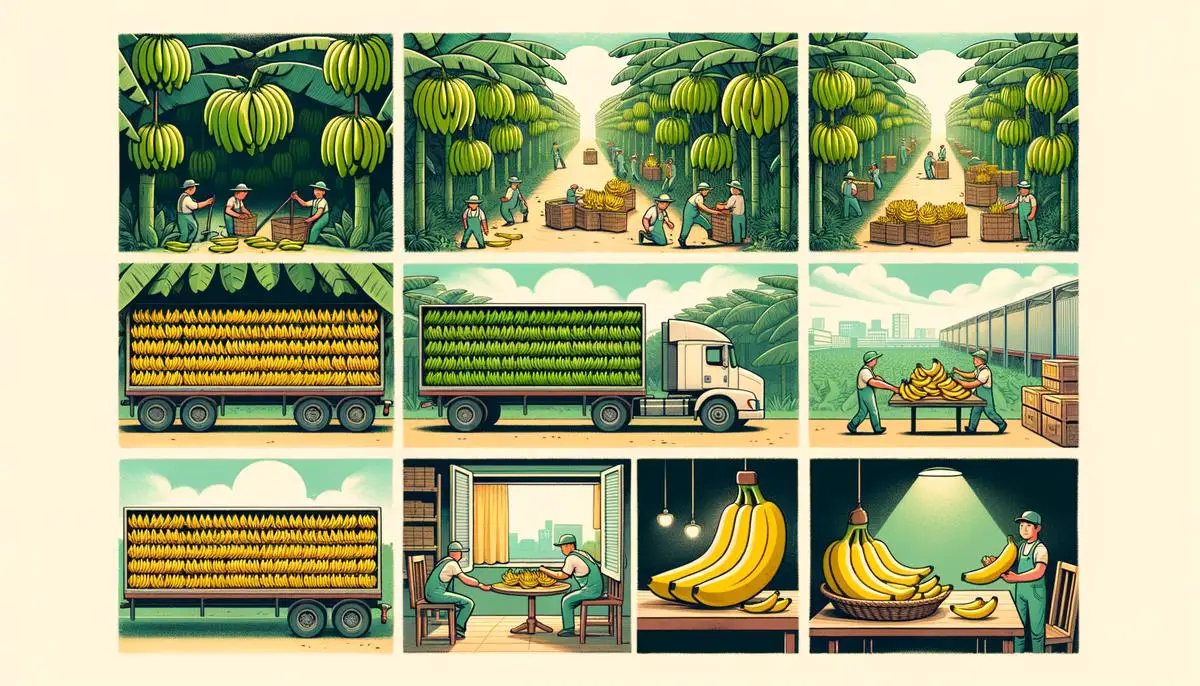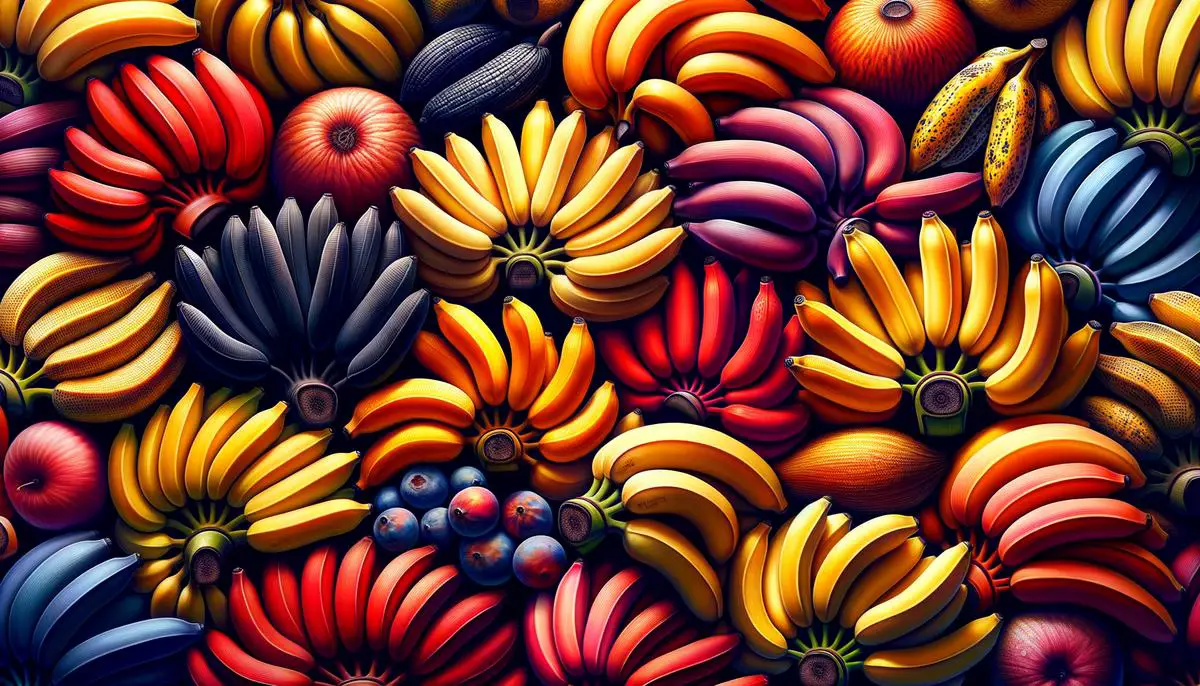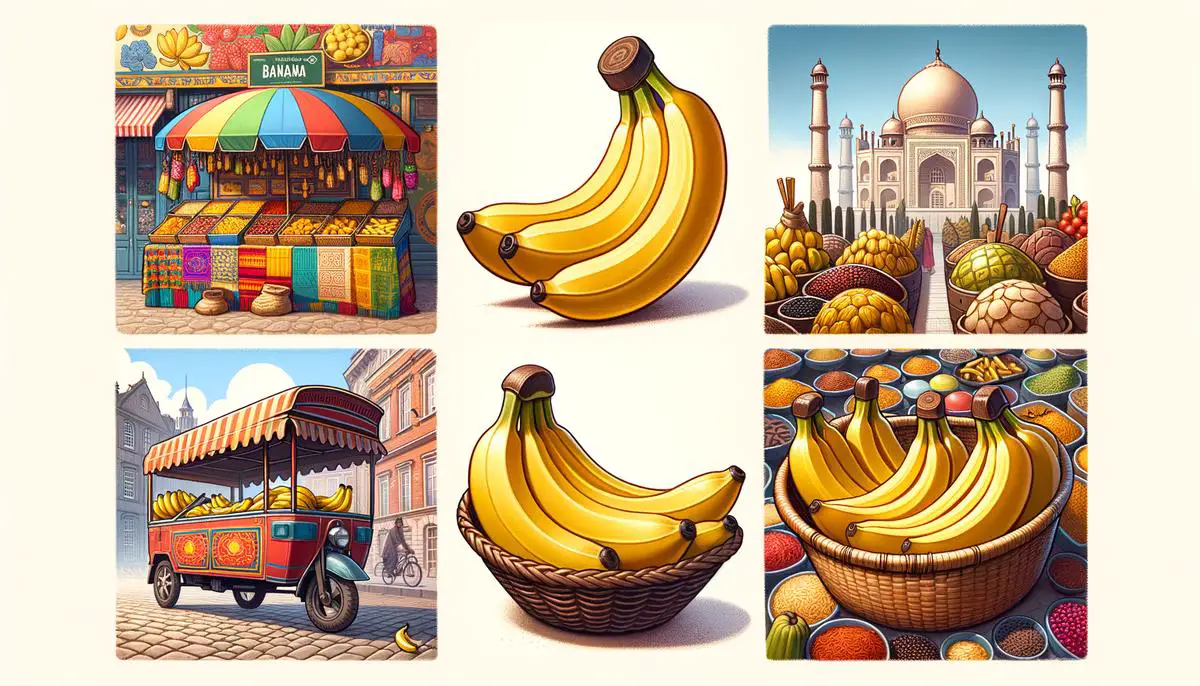Hey there! Ever wondered about the humble banana’s epic journey before it lands on your kitchen counter? Well, buckle up because we’re about to embark on a fascinating trip from the banana farms to your fruit bowl. Along the way, we’ll meet some colorful characters and discover just how much effort goes into delivering these yellow bundles of joy.
The Journey of Bananas
Bananas start their journey in warm climates. Here, they grow on plants that can reach up to 25 feet tall. Each plant produces a single bunch of bananas, which can have up to 200 bananas split into ‘hands’. When the bananas are still green and firm, farmers cut them down. This early harvest prevents bruises and ensures the bananas can handle the trip ahead.
After harvest, workers carefully pack these green bananas into boxes. They stuff these boxes with protective materials to stop the bananas from bumping into each other. Think of it like padding a box when you’re sending a fragile gift in the mail. You don’t want your gift to arrive in pieces, right? Same with bananas.
The next stop for these boxed bananas is often a cooling facility. Cooling slows down the ripening process. If bananas get too ripe too soon, they’ll be mushy by the time they get to eat them. So, this cooling step is like pressing pause on the bananas’ ripening, giving them more time to travel.
Once they’re cooled, the bananas take a big trip on refrigerated boats or trucks. These aren’t your average vehicles; they’re specially designed to keep bananas at just the right temperature and humidity. It’s a bit like how some people travel in style in first-class seats, ensuring they arrive at their destination feeling fresh.
Arriving at their destination country, bananas face customs. It’s like when travelers show their passports. Once cleared, it’s off to ripening chambers. Now, remember how we pressed pause on the bananas’ ripening process? Here’s where we hit play again. These chambers use ethylene gas to wake the bananas up and get them ripening, turning them that perfect shade of yellow we all know and love.
Next, bananas meet another set of transportation, possibly more trucks, to carry them to their final stops: Supermarkets, stores, and sometimes directly to local markets.
Throughout their journey, lots of people work hard to check the bananas’ progress and well-being. It’s as if the bananas have personal bodyguards ensuring they make it safely to our tables.
And that’s how bananas embark on an international voyage before arriving at our homes, ready for us to enjoy. From farmers, sorters, packers, shippers to those who handle them in our local stores, it takes a village to bring bananas from farms to our tables.

Banana Varieties Around the World
Diving straight into the heart of banana diversity, it’s important to note that bananas come in more than just the bright yellow skins we’re accustomed to. Think of bananas, and you might picture the standard Cavendish variety, but the truth is, the world of bananas is vast and varied, filled with intriguing flavors and textures.
Let’s embark on a journey to explore red bananas, for instance, which pack a sweet punch coupled with a creamy texture. Originating from Southeast Asia and East Africa, these ruby-toned delights are known for their rosy hue and raspberry-like flavor. Unlike their yellow counterparts, red bananas are often shorter and plumper, making them a distinctive sight in fruit markets.
Switching gears, we encounter the robust plantains, the starchy siblings in the banana family. Prevalent in Latin American, Caribbean, and African cuisines, plantains are larger and tougher than dessert bananas and are usually cooked before eating. Often fried, boiled, or grilled, they play a central role in many traditional dishes, adding a unique flavor profile that bridges the gap between sweet and savory.
For those interested in a bit sweeter and aromatic experience, the Lady Finger banana, or “Baby banana,” is a treat. Smaller in size but packed with sweetness and a smooth texture, these bananas are perfect for snacking or dessert options. Easily distinguishable by their miniature size, they’re grown primarily in South America but are making their way into more international markets due to their delightful taste.
Continuing our voyage to Africa, we stumble upon the East African Highland bananas. These bananas are not typically eaten raw but instead cooked and are a staple food in the East African diet, similar to how potatoes might be viewed in Western dishes. Heavier and more substantial than what many are accustomed to, these bananas embody the versatility and cultural significance of bananas around the globe.
While on the topic of tasteful variety, it’s impossible to overlook the Blue Java banana, known for its ice cream-like consistency and flavor reminiscent of vanilla. This type, with its unusual blue-tinged skin when unripe, thrives in cooler regions of Asia and the Pacific. It stands out not just for its color but for providing a dessert-like experience unlike any other banana variety.
The incredible diversity among bananas extends beyond taste and cultivar; it represents the adaptability of this fruit to different soils and climates across the world. From the mountainous regions of Southeast Asia to the tropical climates of South America, each variety has adapted to thrive in its environment, bringing with it a piece of local culture and cuisine.
What becomes evident through exploring these varied types of bananas is not just the rich tapestry of flavors and uses but the interconnectedness of food and culture. Each banana variety tells a story of geographical adaptation, culinary innovation, and cultural significance. As we peel back the layers of each type, we uncover more than just fruit; we discover a world ripe with diversity and flavor.

The Cultural Significance of Bananas
In many Asian cultures, bananas hold a symbolic element in religious ceremonies and offerings. Often found on altars, they are presented to gods and ancestors as a sign of respect and piety. The banana’s yellow color, often associated with prosperity and happiness, makes it a staple offering during festivals and worship activities. In Hinduism, for instance, bananas are considered a ‘fruit of the Earth,’ symbolizing fertility and abundance.
Across the Pacific, in Papua New Guinea, bananas are more than just food; they’re part of a tradition. The ‘banana mama’ ceremony showcases the community’s connection to this fruit. Here, after a woman gives birth, she must plant a banana as a symbol of her child’s growth and the continuation of life. This ritual underlines the banana as a symbol of life and growth in their community.
In the Caribbean, the banana has danced its way into musical rhythms and cultural expressions. In reggae and calypso songs, bananas are celebrated for their cultural significance and economic impact. These musical genres, often reflecting the social and political narratives of the times, occasionally pay homage to the banana industry’s role in shaping islands’ economies and histories. In Japan, banana art has emerged as an unexpected cultural trend. Artists meticulously carve intricate patterns and scenes into the banana skin, transforming the fruit into transient works of art that captivate social media platforms before decomposing. This modern cultural phenomena resonates with the Japanese aesthetic value of fleeting beauty, symbolized by the impermanence of these banana artworks.Furthermore, bananas have carved their niche within global culinary traditions. In the Philippines, banana leaves are used as eco-friendly packaging material for foods, influencing trends towards sustainable consumption practices worldwide. The sight of food wrapped in banana leaves evokes a sense of tradition and ecological consciousness, blending culinary practices with environmental stewardship.
- In Africa, bananas have transformed economies. In Uganda, ‘Matooke,’ a dish made from mashed bananas, stands as a testament to the crop’s integral role in East African cuisine and economy. The cultivation and sale of bananas support countless families, fueling small-scale industries and contributing significantly to local economies. The banana, thus, is not just a nutrient provider but a cornerstone of economic stability for many.

So, there you have it – a whirlwind tour of the banana’s globe-trotting adventure. It’s more than just a fruit; it’s a traveler with stories to tell and miles under its belt. Next time you peel back that yellow skin, remember the journey it took and all the folks who helped along the way. Bananas might just be one of nature’s simplest pleasures, but their story is as rich and layered as any out there.
